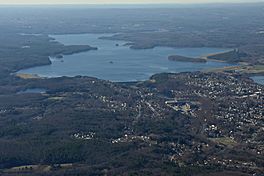Wachusett Reservoir facts for kids
Quick facts for kids Wachusett Reservoir |
|
|---|---|

Wachusett Reservoir and Dam from above Clinton, Massachusetts
|
|
| Location | Worcester County, Massachusetts, United States |
| Coordinates | 42°22′10″N 71°44′18″W / 42.36944°N 71.73833°W |
| Type | Reservoir |
| Primary inflows | Quinapoxet River, Stillwater River, Quabbin Aqueduct |
| Primary outflows | Wachusett Aqueduct, Cosgrove Tunnel, South Nashua River |
| Catchment area | 108 sq mi (280 km2) |
| Basin countries | United States |
| Max. length | 7 mi (11 km) |
| Max. width | 1.1 mi (1.8 km) |
| Surface area | 7 sq mi (18 km2) |
| Average depth | 48 ft (15 m) |
| Max. depth | 120 ft (37 m) |
| Water volume | 65,000,000,000 US gal (0.25 km3) |
| Shore length1 | 21 mi (34 km) |
| Surface elevation | 384 ft (117 m) |
| Settlements | Clinton, West Boylston, Boylston, Sterling |
| 1 Shore length is not a well-defined measure. | |
The Wachusett Reservoir is the second largest body of water in the state of Massachusetts. It is located in central Massachusetts, just northeast of Worcester. This large reservoir is a key part of the water supply system for the greater Boston area. The Massachusetts Water Resources Authority (MWRA) manages it.
The reservoir can hold about 65 billion gallons of water and covers almost 7 square miles. Water from the Wachusett Reservoir travels through the Cosgrove Tunnel to the Norumbega Storage Facility. The reservoir is about 48 feet deep on average, but its deepest point is 120 feet.
The Wachusett Reservoir acts as a storage area for water coming from the Quabbin Reservoir. It also gets water from its own surrounding land. Rivers like the Quinapoxet and Stillwater flow into it. The Quabbin Aqueduct also brings water from the Quabbin Reservoir to Wachusett. The Wachusett Reservoir is the starting point for the Nashua River. Its water levels stay fairly steady, unlike the Quabbin Reservoir, which changes more with rain and demand.
Contents
Building the Wachusett Reservoir
The Wachusett Reservoir was created by building a large dam.
How the Reservoir Was Built
In 1897, work began to block the Nashua River near the town of Clinton. This project involved building the Wachusett Dam. When the dam was finished, a huge area of 4,380 acres was flooded. This land was part of the towns of Boylston, West Boylston, Clinton, and Sterling. Many people had to move their homes and businesses.
When the Reservoir Was Completed
The construction of the dam was completed in 1905. The reservoir then slowly filled with water, and it was completely full by May 1908. At first, water from Wachusett was sent to the Sudbury Reservoir through the Wachusett Aqueduct. Later, in 1965, the Cosgrove Tunnel was built to provide another way to move the water.
The Old Stone Church
A famous landmark in West Boylston, the Old Stone Church, was left standing when the area was flooded. It serves as a reminder of the homes and jobs that were lost when the reservoir was built. Today, it is one of the most photographed spots in the area.
A World Record Reservoir
When it was built, the Wachusett Reservoir was the largest public water supply reservoir in the world. It was also the biggest body of water in Massachusetts. Since then, the Quabbin Reservoir has been built and is now larger.
Fun Activities and Rules
The Wachusett Reservoir is a source of drinking water for many people. Because of this, there are special rules to keep the water clean.
Rules for Visiting the Reservoir
Not all areas around the reservoir are open to the public. To protect the water quality, certain activities are not allowed. These rules include:
- No boats on the water.
- No ice fishing.
- No wading or swimming.
- No camping overnight.
- No alcoholic drinks.
- No littering.
- No animals (like pets).
- No bikes or motor vehicles on the reservoir property.
Some people who enjoy outdoor activities or fishing think these rules are too strict. However, the rules are in place to make sure the drinking water stays clean and safe.
Enjoying the Outdoors
Even with the rules, there are still ways to enjoy the area. A network of fire roads makes it easy for people to go hiking. In winter, these roads are great for cross-country skiing.
Fishing at Wachusett Reservoir
In 1999, scientists found 24 different types of fish in the reservoir. Twelve of these were native to the area, and twelve had been introduced. Because access is limited and the habitat is good, the reservoir has produced state record-breaking fish. These include brown trout, land-locked salmon, smallmouth bass, and white perch. About 80% of the 21-mile shoreline is usually open for fishing. Fishing is allowed from April 1 through November 30, depending on how much ice is on the water.
Images for kids








